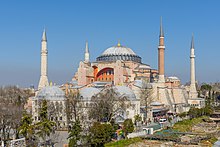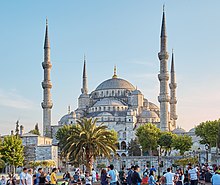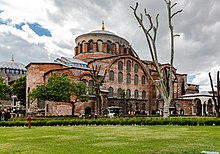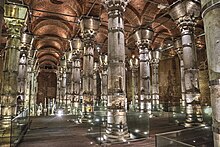world.wikisort.org - Turkey
Fatih (Turkish pronunciation: [ˈfaːtih]) is a district of and a municipality (belediye) in Istanbul, Turkey, and home to almost all of the provincial authorities (including the governor's office, police headquarters, metropolitan municipality and tax office) but not the courthouse. It encompasses the peninsula coinciding with old Constantinople. In 2009, the district of Eminönü, which had been a separate municipality located at the tip of the peninsula, was once again remerged into Fatih because of its small population. Fatih is bordered by the Golden Horn to the north and the Sea of Marmara to the south, while the Western border is demarked by the Theodosian wall and the east by the Bosphorus Strait.

This article has multiple issues. Please help improve it or discuss these issues on the talk page. (Learn how and when to remove these template messages)
|
Fatih | |
|---|---|
District | |
 Hagia Sophia in Fatih | |
 Location of Fatih in Istanbul | |
 Fatih  Fatih  Fatih | |
| Coordinates: 41°01′03″N 28°56′26″E[1] | |
| Country | Turkey |
| Province | İstanbul |
| Named for | Constantine I (Constantinople) Fatih Sultan Mehmet (Fatih) |
| Government | |
| • Mayor | Mehmet Ergün Turan (AKP) |
| • Kaymakam | Hasan Karakaş |
| Area | |
| • District | 13.08 km2 (5.05 sq mi) |
| Population (2012)[3] | |
| • District | 428,857 |
| • District density | 33,000/km2 (85,000/sq mi) |
| Website | www |
History
Byzantine era


Historic Byzantine districts encompassed by present-day Fatih include: Exokiónion, Aurelianae, Xerólophos, ta Eleuthérou, Helenianae, ta Dalmatoú, Sígma, Psamátheia, ta Katakalón, Paradeísion, ta Olympíou, ta Kýrou, Peghé, Rhéghion, ta Elebíchou, Leomákellon, ta Dexiokrátous, Petríon or Pétra, Phanàrion, Exi Mármara (Altımermer), Philopátion, Deúteron and Vlachernaí.


Ottoman period


The name "Fatih" comes from the Ottoman emperor Fatih Sultan Mehmed (Mehmed the Conqueror), and means "Conqueror" in Turkish, originally from Arabic. The Fatih Mosque built by Mehmed II is in this district, while his resting place is next to the mosque and is much visited. It was on the ruins of the Church of the Holy Apostles, destroyed by earthquakes and years of war, that the Fatih Mosque was built, and around the mosque a large madrasa complex.

Immediately after the conquest, groups of Islamic scholars transformed the major churches of Hagia Sophia and the Pantocrator (today the Zeyrek Mosque) into mosques, but the Fatih Mosque and its surrounding complex was the first purpose-built Islamic seminary within the city walls. The building of the mosque complex ensured that the area continued to thrive beyond the conquest; markets grew up to support the thousands of workers involved in the building and to supply them with materials, and then to service the students in the seminary. The area quickly became a Turkish neighbourhood with a particularly pious character due to the seminary. Some of this piety has endured until today.

Following the conquest, the Edirnekapı (meaning Edirne Gate) gate in the city walls became the major exit to Thrace, and this rejuvenated the neighbourhoods overlooking the Golden Horn. The Fatih Mosque was on the road to Edirnekapı and the Fatih district became the most populous area of the city in the early Ottoman period and in the 16th century more mosques and markets were built in this area, including: Iskender Pasha Mosque, once famous as a centre for the Naqshbandi order in Turkey); Hirka-i-Sharif Mosque, which houses the cloak of the Prophet Muhammad (The Mosque is in common use but the cloak is only on show during the month of Ramadan; the Jerrahi Tekke; The Sunbul Efendi Tekke and the Ramazan Efendi Tekke both in the Kocamustafapaşa district and the Vefa Kilise Mosque, originally a Byzantine church. The last four were named after the founders of various Sufi orders, and Sheikh Ebü’l Vefa in particular was of major importance in the city and was very fond of Fatih. Many other mosques, schools, baths, and fountains in the area were built by military leaders and officials in the Ottoman court.
From the 18th century onwards, Istanbul started to grow outside the walls, and then began the transformation of Fatih into the heavily residential district, dominated by concrete apartment housing, that it remains today. This process was accelerated over the years by fires which destroyed whole neighbourhoods of wooden houses, and a major earthquake in 1766, which destroyed the Fatih Mosque and many of the surrounding buildings (subsequently rebuilt). Fires continued to ravage the old city, and the wide roads that run through the area today are a legacy of all that burning. There are few wooden buildings left in Fatih today, although right up until the 1960s, the area was covered with narrow streets of wooden buildings. Nowadays, the district is largely made up of narrow streets with tightly packed 5- or 6-floor apartment buildings.
The confectioner Hafiz Mustafa 1864 was founded in 1864 by Hadji İsmail Hakkı Beyat what is today Hamidiye street in the district during the reign of Sultan Abdulaziz.[4]
Fatih today



At present, Fatih contains areas including Aksaray, Fındıkzade, Çapa, and Vatan Caddesi that are more cosmopolitan than the conservative image which the district has in the eyes of many people. With Eminönü, which was again officially a part of the Fatih district until 1928, and with its historical Byzantine walls, conquered by Mehmed II, Fatih is the "real" Istanbul of the old times, before the recent enlargement of the city that began in the 19th century.
The area has become more and more crowded from the 1960s onwards, and a large portion of the middle-class residents have moved to the Anatolian side and other parts of the city. Fatih today is largely a working-class district, but being a previously wealthy area, it is well-resourced, with a more thoroughly established community than the newly built areas such as Bağcılar or Esenler to the west, which are almost entirely inhabited by post-1980s migrants who came to the city in desperate circumstances. Fatih was built with some degree of central planning by the municipality.
Istanbul University which was founded in 1453 is in Fatih. In addition, since 1586, the Orthodox Christian Patriarchate of Constantinople has had its headquarters in the relatively modest Church of St. George in the Fener neighborhood of Fatih.


Fatih has many theatres, including the famous Reşat Nuri Sahnesi. The area is well-served with a number of schools, hospitals and public amenities in general. A number of Istanbul's longest-established hospitals are in Fatih, including the Istanbul University teaching hospitals of Çapa and Cerrahpaşa, the Haseki Public Hospital, the Samatya Public Hospital, and the Vakıf Gureba Public Hospital. A tramway runs from the docks at Sirkeci, through Sultanahmet, and finally to Aksaray, which is a part of Fatih.

Also, besides the headquarters, some main units of the Istanbul Metropolitan Municipality, including the city's fire department, are based in Fatih.

Fatih has many historic and modern libraries, including the Edirnekapı Halk Kütüphanesi, Fener Rum Patrikhanesi Kütüphanesi (the Library of the Patriarchate), Hekimoğlu Ali Paşa Halk Kütüphanesi, İstanbul University Library, İstanbul University Cerrahpaşa Tıp Fakültesi Kütüphanesi, İstanbul Üniversitesi Kardiyoloji Ensitütüsü Kütüphanesi, İstanbul Üniversitesi Tıp Fakültesi Hulusi Behçet Kitaplığı, İstanbul Büyükşehir Belediyesi Kadın Eserleri Kütüphanesi, Millet Kütüphanesi, Mizah Kütüphanesi, Murat Molla Halk Kütüphanesi, Ragıppaşa Kütüphanesi, and Yusufpaşa Halk Kütüphanesi.


On the other hand, today Fatih is known as one of the most conservative and peaceful religious areas of Istanbul because of the religious residents of the Çarşamba quarter which is essentially a very minor part of this historical district. Çarşamba is famous with bearded men in heavy coats, the traditional baggy 'shalwar' trousers and Islamic turban; while women dressed in full black gowns are a common sight as this area is popular with members of a Naqshbandi Sufi order affiliated to Sheikh Mahmut Ustaosmanoğlu. Conservative political parties always do well in this area.
Küçükçekmece, Başakşehir, Bağcılar, Gaziosmanpaşa, Esenler, Bayrampaşa, Zeytinburnu, and Fatih are home to asylum seekers of Syrian origin.[5]
Climate
Fatih experiences a Mediterranean climate (Csa/Cs) according to both Köppen and Trewartha climate classifications, with cool winters and warm to hot summers. It is in USDA hardiness zone 9a and AHS heat zone 4.[6]
| Climate data for Fatih | |||||||||||||
|---|---|---|---|---|---|---|---|---|---|---|---|---|---|
| Month | Jan | Feb | Mar | Apr | May | Jun | Jul | Aug | Sep | Oct | Nov | Dec | Year |
| Average high °C (°F) | 8.6 (47.5) |
8.7 (47.7) |
10.7 (51.3) |
15.8 (60.4) |
20.6 (69.1) |
25.3 (77.5) |
27.6 (81.7) |
27.4 (81.3) |
24.2 (75.6) |
19.4 (66.9) |
15.0 (59.0) |
11.0 (51.8) |
17.9 (64.1) |
| Daily mean °C (°F) | 5.9 (42.6) |
5.9 (42.6) |
7.3 (45.1) |
11.6 (52.9) |
16.2 (61.2) |
20.7 (69.3) |
23.2 (73.8) |
23.2 (73.8) |
20.0 (68.0) |
15.8 (60.4) |
11.7 (53.1) |
8.3 (46.9) |
14.2 (57.5) |
| Average low °C (°F) | 3.1 (37.6) |
3.0 (37.4) |
3.9 (39.0) |
7.4 (45.3) |
11.8 (53.2) |
16.0 (60.8) |
19.1 (66.4) |
19.3 (66.7) |
15.7 (60.3) |
12.1 (53.8) |
8.4 (47.1) |
5.5 (41.9) |
10.4 (50.8) |
| Average precipitation mm (inches) | 101 (4.0) |
69 (2.7) |
70 (2.8) |
51 (2.0) |
33 (1.3) |
31 (1.2) |
23 (0.9) |
32 (1.3) |
46 (1.8) |
71 (2.8) |
90 (3.5) |
122 (4.8) |
739 (29.1) |
| Source: [7] | |||||||||||||
Neighborhoods
There are 57 neighbourhoods in Fatih as of 2017.[8]
- Aksaray
- Akşemsettin
- Alemdar
- Ali Kuşcu
- Atikali
- Ayvansaray
- Balabanağa
- Balat
- Beyazıt
- Binbirdirek
- Cankurtaran
- Cerrahpaşa
- Cibali
- Demirtaş
- Dervişali
- Emin Sinan
- Hacıkadın
- Haseki Sultan
- Hırka-İ Şerif
- Hobyar
- Hoca Gıyasettin
- Hoca Paşa
- İskenderpaşa
- Kalenderhane
- Karagümrük
- Katip Kasım
- Kemal Paşa
- Kocamustafapaşa
- Küçük Ayasofya
- Mercan
- Mesih Paşa
- Mevlanakapı
- Mimar Hayrettin
- Mimar Kemalettin
- Molla Gürani
- Mollafeneri
- Mollahüsrev
- Muhsine Hatun
- Nişanca
- Rüstem Paşa
- Saraç İshak
- Sarıdemir
- Seyyid Ömer
- Silivrikapı
- Sultan Ahmet
- Sururi
- Süleymaniye
- Sümbül Efendi
- Şehremini
- Şehsuvarbey
- Tahtakale
- Taya Hatun
- Topkapı
- Yavuz Sinan
- Yavuz Sultan Selim
- Yedikule
- Zeyrek
Historical sites




- Topkapı Palace - historical residence of the Ottoman sultans
- Hagia Sophia - historical patriarchal cathedral of the Eastern Orthodox Church in the Byzantine Empire's capital city, later converted into a mosque, then a museum, then a mosque again.
- Süleymaniye – the huge mosque complex of Suleiman the Magnificent;
- Turkish and Islamic Arts Museum – formerly the palace of Pargalı Ibrahim Pasha one of the grand viziers and husband of the Sultan's sister, Hatice Sultan
- Yeni Mosque (The new mosque) – the mosque that dominates the waterfront by the Galata Bridge; there is a wide open space in front where people feed the pigeons.
- Grand Bazaar – as much to look at as to shop in.
- Spice Bazaar – another Ottoman caravanserai, not as huge as the Grand Bazaar but right on the water, next to the Yeni Mosque;
- Sokollu Mehmet Pasha Mosque – in Kadirga District (the Byzantine Sophianòn Limin in Greek).
Demographics
|
|
Media
The offices of the magazine Servet-i Fünun were in "Stamboul" (what is now Fatih district) during the magazine's existence.[10]
Visitor attractions
Today, there are still remnants of the sea walls along the Golden Horn and along the Marmara shore, to give a sense of the shape of the old walled city. There are also a number of important architectural structures in the Fatih district, including the Valens Aqueduct across the Atatürk Bulvarı, the fortress on the city walls at Yedikule, the Byzantine Palace of the Porphyrogenitus, the Roman column of Marcian, the Fethiye Cami (the former Byzantine church of Christ Pammakaristos), the Kariye Camii (the former Byzantine church of the Chora), Gül Camii (another former Byzantine church), Fenari Isa Camisi (a complex of two Byzantine churches), the Greek Patriarchate with the Church of St. George in the Fener district, the Church of St. Stephen ("The Iron Church"), the Yavuz Selim Camii, the House-Museum of Dimitrie Cantemir, and the Fatih Mosque itself.
The tombs of some of the famous Ottoman sultans are in Fatih. These include Mehmed II 'the Conqueror' (Fatih Sultan Mehmed), Selim I (Yavuz Sultan Selim), Suleyman the Magnificent, and Abdul Hamid Khan, as well as other leading statesmen of the Ottoman Empire, including Gazi Osman Pasha. Fatih also has a collection of various cuisines (Syrian, Korean, Indian).
International relations
Fatih is twinned with:
See also
- Üsküdar
References
- Fatih, Turkey in Geonames.org (cc-by)
- "Area of regions (including lakes), km²". Regional Statistics Database. Turkish Statistical Institute. 2002. Retrieved 2013-03-05.
- "Population of province/district centers and towns/villages by districts - 2012". Address Based Population Registration System (ABPRS) Database. Turkish Statistical Institute. Retrieved 2013-02-27.
- "Sweets that saw the birth of modern Turkey". June 2019.
- HAYATA DESTEK (31 August 2013). Syrian Refugees in Turkey (PDF) (Report). SUPPORT TO LIFE. pp. 4–5.
- "Bitki Soğuğa ve Sıcağa Dayanıklılık". www.mgm.gov.tr. Retrieved 2021-04-28.
- "Fatih - Weather History & Climate Data - Meteostat". meteostat.net. Retrieved 2021-06-22.
- Turkish Ministry of the Interior. "Civilian Administrative Units in Turkey" (in Turkish). Retrieved 2017-01-31.
- Turkish Statistical Institute
- "Not stated". Servet-i Fünun (1332). 1917-01-04.
- "Wiesbaden's international city relations". Retrieved 24 December 2012.
External links
На других языках
[de] Fatih (Istanbul)
Fatih ist eine Stadtgemeinde (Belediye) im gleichnamigen Ilçe (Landkreis) der Provinz Istanbul in der türkischen Marmararegion und gleichzeitig ein Stadtbezirk der 1984 gebildeten Büyükşehir belediyesi İstanbul (Großstadtgemeinde/Metropolprovinz). Fatih liegt auf der europäischen Seite der Großstadt und ist seit der Gebietsreform ab 2013 flächen- und einwohnermäßig identisch mit dem Landkreis.- [en] Fatih
[es] Distrito de Fatih
Fatih (en español, Conquistador) es uno de los distritos más grandes de Estambul, Turquía, situado en el corazón de la ciudad. Debido a que constituye el barrio antiguo de la ciudad conquistado por Mehmed II el Conquistador, actualmente también se lo conoce como el "verdadero Estambul" o el "primer Estambul". Hoy en día, constituye la península de Estambul hasta la muralla, lo que fue la capital del Imperio bizantino, Constantinopla. Cuenta con una población de 443 955 habitantes (2008).Другой контент может иметь иную лицензию. Перед использованием материалов сайта WikiSort.org внимательно изучите правила лицензирования конкретных элементов наполнения сайта.
WikiSort.org - проект по пересортировке и дополнению контента Википедии

